Spotlight on Fort Myers’ Ward 4 art hub at the Collaboratory
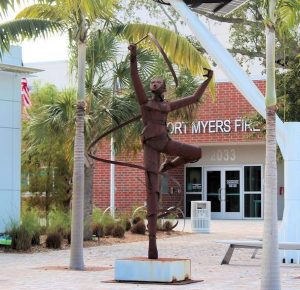 The City of Fort Myers Public Art Committee has been establishing art hubs in each of the City’s six wards using the 23 Edgardo Carmona sculptures that the City purchased in August of 2018. One such art hub is the Collaboratory, which is located in Ward 4 at 2031 Jackson Street adjacent to the Fort Myers Fire Department’s main station. At the behest of City Councilman Liston Bochette and the request of the Collaboratory, the PAC relocated Carmona’s Ribbon Routine (Ena En La Plaza) to the plaza facing west toward the Lee
The City of Fort Myers Public Art Committee has been establishing art hubs in each of the City’s six wards using the 23 Edgardo Carmona sculptures that the City purchased in August of 2018. One such art hub is the Collaboratory, which is located in Ward 4 at 2031 Jackson Street adjacent to the Fort Myers Fire Department’s main station. At the behest of City Councilman Liston Bochette and the request of the Collaboratory, the PAC relocated Carmona’s Ribbon Routine (Ena En La Plaza) to the plaza facing west toward the Lee 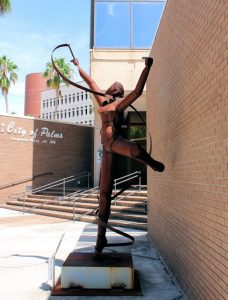 Tran/Greyhound Bus Station.
Tran/Greyhound Bus Station.
The term art hub refers to a location that is either a cultural, residential or business destination. The Collaboratory is unquestionably the latter.
Formerly known as the Southwest Florida Community Foundation, the Collaboratory announced in 2021 that it is committed to bringing Southwest Florida together to solve all of this area’s major social problems by 2040. It is the greatest community problem-solving initiative in American history.
To accomplish this ambitious goal, the Collaboratory is building an infrastructure and assembling partners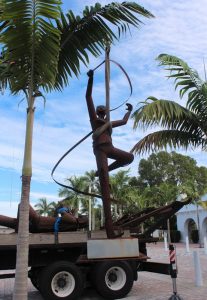 in the business, philanthropic and governmental communities. While many of our local leaders in these economic sectors frequently see and interact with public, private and corporate art, others do not. By making the Collaboratory an art hub, all of these influential decisionmakers will be exposed to the beauty and benefits of public art.
in the business, philanthropic and governmental communities. While many of our local leaders in these economic sectors frequently see and interact with public, private and corporate art, others do not. By making the Collaboratory an art hub, all of these influential decisionmakers will be exposed to the beauty and benefits of public art.
But the Collaboratory is a prime location for an art hub for at least two other reasons. First, it is located directly across the street from the Rosa Parks Greyhound Bus Station. Built more than 20 years ago, the Rosa Parks Transportation Center has evolved into a significant focal point in Lee County’s transportation network. It is currently undergoing a major, $4 million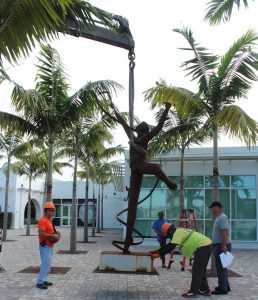 renovation that will enable it to handle the local demand for additional service and amenities. Thanks to a Intermodal Access Development Program grant from the Florida Department of Transportation (FDOT), the terminal will soon have two new bays at the northeast corner of the site on Widman Way, two more street-side bays on the west side of the site along Hendry, and expanded connections for persons with limited mobility. In addition, the facility will gain upgraded technology features and renovations to the interior and exterior of the building, making the space more comfortable and
renovation that will enable it to handle the local demand for additional service and amenities. Thanks to a Intermodal Access Development Program grant from the Florida Department of Transportation (FDOT), the terminal will soon have two new bays at the northeast corner of the site on Widman Way, two more street-side bays on the west side of the site along Hendry, and expanded connections for persons with limited mobility. In addition, the facility will gain upgraded technology features and renovations to the interior and exterior of the building, making the space more comfortable and 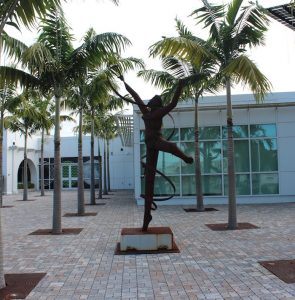 convenient for passengers while improving access for pedestrians and bicyclists.
convenient for passengers while improving access for pedestrians and bicyclists.
According to Lee County Spokesman Tom Engstrom, the hub sees an average of 1,100 riders each day. For many of these passengers, glimpsing Ribbon Routine as they wait or disembark may very well represent their first or only exposure to public art. For newcomers, the Committee also hopes that Ribbon Routine will create a favorable first impression, announcing that they’ve arrived in a town that values art and culture.
Last but by no means least, 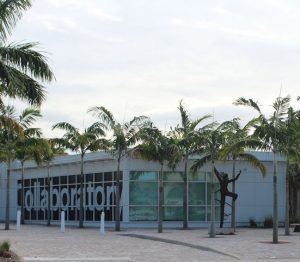 as the 240-acre Midtown district grows and develops in accordance with the City’s Midtown Vision Plan, the Collaboratory will increasingly find itself positioned as a gateway into the River District for the thousands of new residents expected to occupy the residential neighborhoods and patronize the mixed-used activity centers that will complement the historic district and nearby riverfront. While not intended as a gateway artwork, Ribbon Routine has the potential
as the 240-acre Midtown district grows and develops in accordance with the City’s Midtown Vision Plan, the Collaboratory will increasingly find itself positioned as a gateway into the River District for the thousands of new residents expected to occupy the residential neighborhoods and patronize the mixed-used activity centers that will complement the historic district and nearby riverfront. While not intended as a gateway artwork, Ribbon Routine has the potential 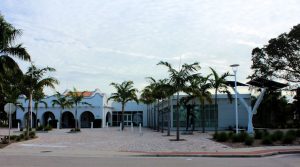 to define this portal-pathway as an entry point into the City’s art and cultural hub.
to define this portal-pathway as an entry point into the City’s art and cultural hub.
Text and photos describing the sculpture have already been added to the City’s free mobile app, Otocast, which provides Fort Myers residents and visitors with background 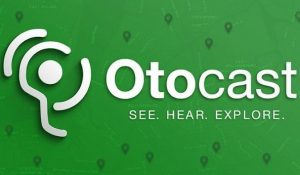 information about 28 of the 40 outdoor artworks in the City’s public art collection. An audio describing how the sculpture reflects and is emblematic of the Collaboratory’s mission is in the process of being recorded and uploaded to the app as well.
information about 28 of the 40 outdoor artworks in the City’s public art collection. An audio describing how the sculpture reflects and is emblematic of the Collaboratory’s mission is in the process of being recorded and uploaded to the app as well.
June 4, 2022.
N.B.: 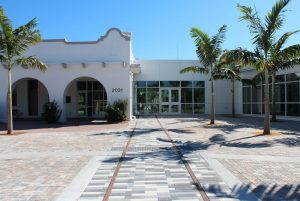 The building that houses the Collaboratory today opened in 1924 as the Atlantic Coast Line Railway Depot. The paths of the old railroad tracks have been marked; the mission-style architecture has been preserved, along with original tiles and ticketing windows. The railroad station remained segregated until it closed in 1971. The original bathroom doors that separated customers by race are still here—
The building that houses the Collaboratory today opened in 1924 as the Atlantic Coast Line Railway Depot. The paths of the old railroad tracks have been marked; the mission-style architecture has been preserved, along with original tiles and ticketing windows. The railroad station remained segregated until it closed in 1971. The original bathroom doors that separated customers by race are still here—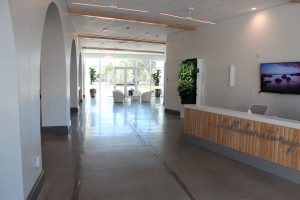 stark reminders of the prejudice that marked another time in this historic place. Today this space is a living monument to aspiration and to the possibility that human beings working together are more powerful than the problems that confront us.
stark reminders of the prejudice that marked another time in this historic place. Today this space is a living monument to aspiration and to the possibility that human beings working together are more powerful than the problems that confront us.
GO 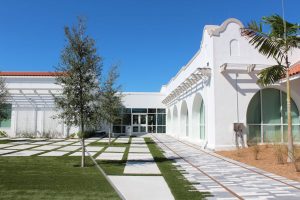 HERE TO LEARN MORE ABOUT THE CITY’S OTHER ART HUBS:
HERE TO LEARN MORE ABOUT THE CITY’S OTHER ART HUBS:














 Tom Hall is both an amateur artist and aspiring novelist who writes art quest thrillers. He is in the final stages of completing his debut novel titled "Art Detective," a story that fictionalizes the discovery of the fabled billion-dollar Impressionist collection of Parisian art dealer Josse Bernheim-Jeune, thought by many to have perished during World War II when the collection's hiding place, Castle de Rastignac in southern France, was destroyed by the Wehrmacht in reprisal for attacks made by members of the Resistance operating in the area. A former tax attorney, Tom holds a bachelor's degree as well as both a juris doctorate and masters of laws in taxation from the University of Florida. Tom lives in Estero, Florida with his fiancee, Connie, and their four cats.
Tom Hall is both an amateur artist and aspiring novelist who writes art quest thrillers. He is in the final stages of completing his debut novel titled "Art Detective," a story that fictionalizes the discovery of the fabled billion-dollar Impressionist collection of Parisian art dealer Josse Bernheim-Jeune, thought by many to have perished during World War II when the collection's hiding place, Castle de Rastignac in southern France, was destroyed by the Wehrmacht in reprisal for attacks made by members of the Resistance operating in the area. A former tax attorney, Tom holds a bachelor's degree as well as both a juris doctorate and masters of laws in taxation from the University of Florida. Tom lives in Estero, Florida with his fiancee, Connie, and their four cats.